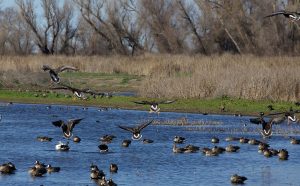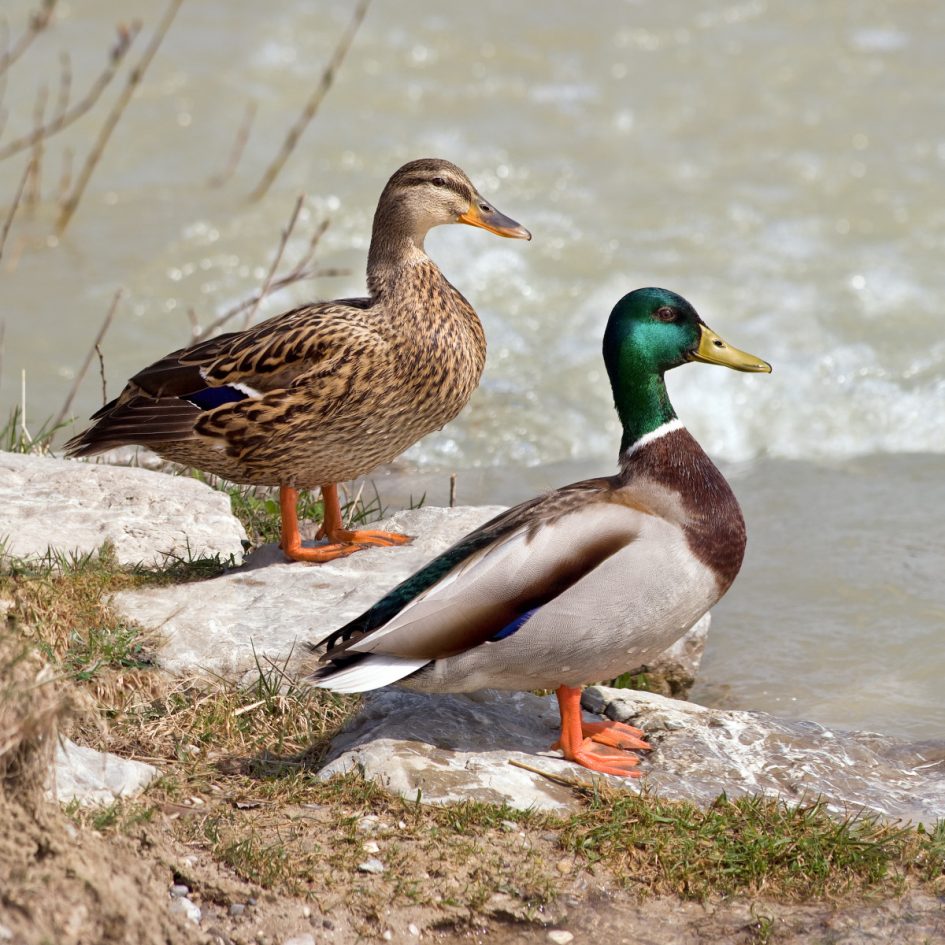Order: Anseriformes
Family: Anatidae
Genus: Anas
Species: Anas platyrhynchos
Introduction: A far as dabbling ducks go, the Mallard duck or, Anas platyrhynchos, is the most common species of duck in North America. This duck can be found in almost any water source across the country. The adult Mallards size ranges from 20 to 26 inches and 1.6 to 3.5 pounds. These ducks are omnivores, giving them a very large range where can feed. Male Mallards have a dark, iridescent-green head and bright yellow bill. The males gray/brown body is sandwiched between a brown breast and black rear. Females and juveniles are mottled brown with orange-and-brown bills. Both the male and female have a white-bordered, blue “speculum” patch in the wing (Cornell Lab of Ornithology. (n.d.).
Anas platyrhynchos reside year-round across most of the United States, populations that breed in Canada and Alaska leave in the fall for wintering sites in the southern U. S. and northern Mexico, typically traveling along well-known migration flyways. They also have the most extended migration period, which lasts from late summer to early winter (Mallard, n.d.).
Mallards can be found in almost any wetland habitat in the United States, such as marshes, bogs, floodplains, rivers, creeks, beaver ponds, lakes, reservoirs, ponds, city parks, farms, estuaries, and even puddles made by a previous rain storm. They can also be found in brackish and salt water.

Colusa National Wildlife Refuge. (2017, June 05).
They are fairly common feeding along roadside ditches, pastures, and croplands. Mallards are known as omnivores, they eat invertebrates, fish, a variety of plants, and in some cases small frogs. When you’re at your local park you might notice duck butts pointed to the sky, this is known as dabbling, when they are feeding on the sustenance below the waters surface.
Admin. (2018, July 03).
Mallards begin courtship in the fall and form pairs by early winter. In late March and early April, the pairs migrate back to the female’s territory close to where she was born, or where she previously nested (David, D. 2019, March 02). Mallards build nests on the ground close to ponds and lay about a dozen eggs. The Mallard chicks can swim and feed within a day after hatching. At the time of breeding season, the male Mallards head color takes on a green sheen to help impress the females. During the courtship and mating process the drake’s head takes on a purple hue, this color gradually changes to black after the female lays her eggs (David, D. 2019, March 02).

Philpott, M. (2011, March 15).
Although the Mallard is the most heavily hunted duck species in North America, its populations have remained more or less steady. Wildlife managers carefully monitor and manage populations and their habitats to ensure the continued benefit of the Mallard and associated wetland species (Mallard. n.d.). One known issue the Mallard faces that could slowly wipe out their species, is hybridizing with other ducks. One subspecies this happens with is the Mexican Duck or, Anas platyrhynchos, occurs in parts of Arizona, New Mexico, Texas, and Mexico. Both males and females closely resemble female Mallards, although the body color is somewhat darker than a typical female Mallard (Cornell Lab of Ornithology, n.d.).
Admin. (2018, July 03). Duck Call free Download. Retrieved from http://professionalhuntinggears.com/duck-call-free-download/
Bossema, I., Lammers, G. J., & Kruijt, J. P. (1982). Effects of early experience and male activity on mate choice in mallard females (Anas platyrhynchos). Behaviour, 80(1-2), 32-43.
Colusa National Wildlife Refuge. (2017, June 05). Retrieved from https://en.wikipedia.org/wiki/Colusa_National_Wildlife_Refuge
David, D. (2019, March 02). Mallard Duck Nesting Habits. Retrieved from https://sciencing.com/mallard-duck-nesting-habits-8096988.html
Devries, J. H., Brook, R. W., Howerter, D. W., & Anderson, M. G. (2008). Effects of spring body condition and age on reproduction in mallards (Anas platyrhynchos). The Auk, 125(3), 618-628.
Drilling, N., R. D. Titman, and F. McKinney (2018). Mallard (Anas platyrhynchos), version 1.1. In The Birds of North America (P. G. Rodewald, Editor). Cornell Lab of Ornithology, Ithaca, NY, USA.
Greenwood, H., Clark, R. G., & Weatherhead, P. J. (1986). Condition bias of hunter-shot mallards (Anas platyrhynchos). Canadian Journal of Zoology, 64(3), 599-601.
Gunnarsson, G., Elmberg, J., Sjöberg, K., Pöysä, H., & Nummi, P. (2004). Why are there so many empty lakes? Food limits survival of mallard ducklings. Canadian Journal of Zoology, 82(11), 1698-1703.
Mallard. (n.d.). Retrieved from http://www.ducks.org/hunting/waterfowl-id/mallard Overall health of mallards harvested in Canada.
Mallard Identification, All About Birds, Cornell Lab of Ornithology. (n.d.). Retrieved from https://www.allaboutbirds.org/guide/Mallard/id Mallard ID, distribution, habitat, habits.
Philpott, M. (2011, March 15). Nesting Duck ! Retrieved from http://flickr.com/photos/fftang/5529289935
Pöysä, H., Elmberg, J., Sjöberg, K., & Nummi, P. (2000). Nesting mallards (Anas platyrhynchos) forecast brood-stage food limitation when selecting habitat: experimental evidence. Oecologia, 122(4), 582-586.
Pöysä, H., Elmberg, J., Sjöberg, K., & Nummi, P. (1998). Habitat selection rules in breeding mallards (Anas platyrhynchos): a test of two competing hypotheses. Oecologia, 114(2), 283-287.




Leave a Reply